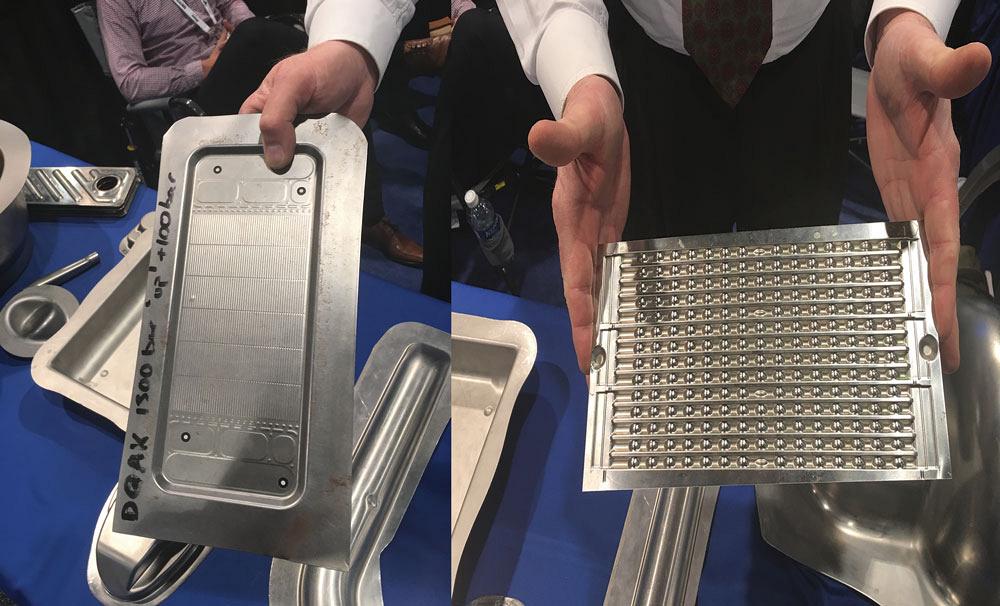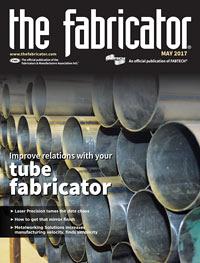Editor-in-Chief
- FMA
- The Fabricator
- FABTECH
- Canadian Metalworking
Categories
- Additive Manufacturing
- Aluminum Welding
- Arc Welding
- Assembly and Joining
- Automation and Robotics
- Bending and Forming
- Consumables
- Cutting and Weld Prep
- Electric Vehicles
- En Español
- Finishing
- Hydroforming
- Laser Cutting
- Laser Welding
- Machining
- Manufacturing Software
- Materials Handling
- Metals/Materials
- Oxyfuel Cutting
- Plasma Cutting
- Power Tools
- Punching and Other Holemaking
- Roll Forming
- Safety
- Sawing
- Shearing
- Shop Management
- Testing and Measuring
- Tube and Pipe Fabrication
- Tube and Pipe Production
- Waterjet Cutting
Industry Directory
Webcasts
Podcasts
FAB 40
Advertise
Subscribe
Account Login
Search
Technology Spotlight: A new take on forming with fluids
A metal forming technology from Germany delivers intricate forming capabilities using water but without some of the pains associated with hydroforming
- By Dan Davis
- May 5, 2017
- Article
- Hydroforming

Figure 1a and 1b
The fluid forming process can create part features that are minimal (left) and well-defined (right).
Hydroforming—the use of fluid to form metal parts—generated a great deal of excitement a little more than 15 years ago. It even spawned a short-lived trade publication called Hydroforming Journal, brought to you by your friends at FMA Communications. (The publisher ceased publishing the magazine in 2005 after roughly six years.)
The process involved the use of a high-pressured fluid—hydraulic oil in the early 20th century—to force sheet metal into the shape of the mold into which it was forced. A rubber bladder separated the oil from the sheet metal blanks.
The process gained attention at the beginning of the 21st century because it could deliver complex shapes in thin metal. That translated into lighter parts that also demonstrated attractive stiffness-to-weight ratios, a key benefit for automakers having to meet stringent miles-per-gallon goals set forth by the federal government.
But you also had an issue with bladder control in this legacy technology. Under heavy pressures, that rubber bladder wanted to move. (Forming pressures typically were limited to approximately 10,000 to 15,000 lbs.) The bladder also could tear and got in the way of producing intricate geometries.
That led some German engineers to think how they could improve upon the process while still delivering on the promise of using a fluid as a forming agent. They came up with their answer about 12 years ago, and they have been proving it out in Europe over the ensuing years.
“The idea was that we wanted to build a better mousetrap,” said Paul Benny, president, FluidForming Americas LLC, the Hartsville, Tenn., company marketing the technology in the U.S.
“The real distinctive difference and the reason it works is that with a bladder [in traditional hydroforming], you’ve got to maintain the two die surfaces in parallel throughout the forming process. So much force is exerted there that it can be difficult. Sometimes you can’t make it big, thick, or tough enough, so the bladder ends up finding a way out,” he said. “Plus, you’re limited by the fact that it’s rubber or a rubber compound. You can put only so much pressure on that bladder before it gives.”
FluidForming has developed a way to keep the two pieces of tooling in parallel throughout the entire process and then use pressurized water as the forming agent—without the need for the bladder.
“Our seal can be as simple as the protective film that you see put on regular goods. We can use an O-ring, a steel seal, or nothing at all,” Benny said. “It just depends on the geometry and the amount of force that we need.”
Company officials say that the machines can reach pressures up to 60,000 PSI and form materials up to 0.236 in. (6 mm) thick. This type of fluid forming also allows a manufacturer to achieve truly intricate shapes in thin materials as well (see Figures 1a and 1b). Benny said that the process can form metal as thin as 0.01 in.(0.25 mm).
In both thick and thin materials, the pressure is applied evenly over the blank, allowing the metal to flow into the die during the forming process. Benny said that even areas inside corners show little to no visible stretching after the fluid forming process takes place. He added that springback is virtually eliminated.
“When thinning does occur—and it’s not much—it’s radially uniform around the part,” he said. “So you aren’t pulling off one edge. It’s a very uniform process.”
Because of this lack of impact on the metal surface, this fluid forming approach can be used with prepainted metals and metals with certain surface treatments, such as special brushing or prepatterns. Even highly polished surfaces will not dull during the forming process, according to company officials. Again, this occurs because the metal is expanded into and against the die wall, not stretched over a die surface.
The lack of rework ties in with the message that FluidForming is trying to share with manufacturing companies in the U.S.: This type of metal forming process is attractive when total cost of ownership is considered. When a company buys into fluid-formed parts as opposed to conventionally formed parts, Benny said, they can expect to see less rework of production parts and reduced tooling costs. In many instances, the same tool that is made for prototyping can be used for production, if prototype parts are approved, of course.
In some instances, tooling can be 3-D printed plastic or even aluminum.
“If you need 20 parts and you need to print the tooling, you could have a metal part formed tomorrow,” Benny said. “That can’t be done today.”
FluidForming Americas LLC, 800-497-3545, www.ffamericas.com
About the Author

Dan Davis
2135 Point Blvd.
Elgin, IL 60123
815-227-8281
Dan Davis is editor-in-chief of The Fabricator, the industry's most widely circulated metal fabricating magazine, and its sister publications, The Tube & Pipe Journal and The Welder. He has been with the publications since April 2002.
Related Companies
subscribe now

The Fabricator is North America's leading magazine for the metal forming and fabricating industry. The magazine delivers the news, technical articles, and case histories that enable fabricators to do their jobs more efficiently. The Fabricator has served the industry since 1970.
start your free subscription- Stay connected from anywhere

Easily access valuable industry resources now with full access to the digital edition of The Fabricator.

Easily access valuable industry resources now with full access to the digital edition of The Welder.

Easily access valuable industry resources now with full access to the digital edition of The Tube and Pipe Journal.
- Podcasting
- Podcast:
- The Fabricator Podcast
- Published:
- 04/16/2024
- Running Time:
- 63:29
In this episode of The Fabricator Podcast, Caleb Chamberlain, co-founder and CEO of OSH Cut, discusses his company’s...
- Industry Events
16th Annual Safety Conference
- April 30 - May 1, 2024
- Elgin,
Pipe and Tube Conference
- May 21 - 22, 2024
- Omaha, NE
World-Class Roll Forming Workshop
- June 5 - 6, 2024
- Louisville, KY
Advanced Laser Application Workshop
- June 25 - 27, 2024
- Novi, MI































